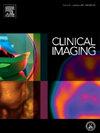基于基线MRI、术前临床协变量预测前列腺切除术后前列腺癌生化复发的多模式自动深度学习模型
IF 1.5
4区 医学
Q3 RADIOLOGY, NUCLEAR MEDICINE & MEDICAL IMAGING
引用次数: 0
摘要
目的开发一种基于多模态深度学习的人工智能算法,并利用MRI和临床数据研究其预测前列腺癌根治性前列腺切除术(RP)后BCR的能力。方法在2008年1月至2018年12月期间,spca患者(n = 311)在RP之前接受了前列腺MRI检查。计算每位患者的CAPRA-S。定量成像特征提取方法发展在以前的研究。测试集结果对研究中的每个模型进行独立评估,使用训练集的交叉验证来调整超参数和选择特征。DeLong检验比较AUROC曲线值,log-rank检验比较无bcr生存曲线值。结果在所有患者中,自动多模态模型的AUROC为0.74,而CAPRA-S模型的AUROC为0.66。该模型的最高灵敏度为75%,CAPRA-S为37%。为每个模型生成测试集的无bcr生存曲线。Log-rank检验表明,每种模型在患者结局之间存在差异(p <;0.05)。自动化多模态模型是唯一具有p <;0.01. 专注于中等风险患者(CAPRA-S评分3-5),这种自动化模型是唯一保持区分结果能力的模型(p <;0.01),而所有其他模型和CAPRA-S未能区分中度风险BCR结果(p >;0.05)。基于定量成像特征和临床协变量的多模态模型的开发表明,自动化多模态人工智能方法最有效地预测PCa患者的BCR。基于AUROC和区分中危患者无bcr生存结果的能力,该模型优于金标准的术后CAPRA-S风险评分。本文章由计算机程序翻译,如有差异,请以英文原文为准。
A multimodal automated deep learning-based model for predicting biochemical recurrence of prostate cancer following prostatectomy from baseline MRI, Presurgical clinical covariates
Purpose
To develop a multimodal deep learning-based AI algorithm and investigate its ability to predict BCR of PCa after radical prostatectomy (RP) using MRI and clinical data.
Methods
PCa patients (n = 311) underwent prostate MRI prior to RP between January 2008 and December 2018. For each patient, CAPRA-S was calculated. Quantitative imaging features were extracted using methods developed in a previous study. Test set results were assessed independently for each model in the study, using cross-validation of the training set to tune hyperparameters and select features. DeLong's test compared AUROC curve values, and log-rank tests compared BCR-free survival curves.
Results
Across all patients, the AUROC of the automated multimodal model was 0.74, compared to 0.66 for CAPRA-S. This model had the highest sensitivity at 75 %, with CAPRA-S at 37 %. BCR-free survival curves for the test set were generated for each model. Log-rank tests indicated each model differentiated between patient outcomes (p < 0.05). The automated multimodal model was the only model with p < 0.01. Focusing on intermediate risk patients (CAPRA-S scores 3–5), this automated model was the only model which maintained the ability to differentiate between outcomes (p < 0.01), while all other models and CAPRA-S failed to differentiate intermediate risk BCR outcomes (p > 0.05).
Conclusion
Development of a multimodal model using quantitative imaging features and clinical covariates revealed that an automated multimodal AI approach most effectively predicts BCR in PCa patients. Based on AUROC and the ability to differentiate between BCR-free survival outcomes with statistical significance in intermediate risk patients, this model outperforms the gold standard postsurgical CAPRA-S risk scores.
求助全文
通过发布文献求助,成功后即可免费获取论文全文。
去求助
来源期刊

Clinical Imaging
医学-核医学
CiteScore
4.60
自引率
0.00%
发文量
265
审稿时长
35 days
期刊介绍:
The mission of Clinical Imaging is to publish, in a timely manner, the very best radiology research from the United States and around the world with special attention to the impact of medical imaging on patient care. The journal''s publications cover all imaging modalities, radiology issues related to patients, policy and practice improvements, and clinically-oriented imaging physics and informatics. The journal is a valuable resource for practicing radiologists, radiologists-in-training and other clinicians with an interest in imaging. Papers are carefully peer-reviewed and selected by our experienced subject editors who are leading experts spanning the range of imaging sub-specialties, which include:
-Body Imaging-
Breast Imaging-
Cardiothoracic Imaging-
Imaging Physics and Informatics-
Molecular Imaging and Nuclear Medicine-
Musculoskeletal and Emergency Imaging-
Neuroradiology-
Practice, Policy & Education-
Pediatric Imaging-
Vascular and Interventional Radiology
 求助内容:
求助内容: 应助结果提醒方式:
应助结果提醒方式:


